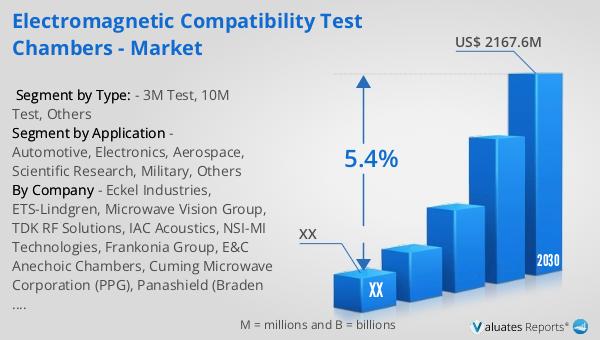What is Electromagnetic Compatibility Test Chambers - Global Market?
Electromagnetic Compatibility (EMC) Test Chambers are specialized environments used to evaluate the electromagnetic compatibility of electronic devices and systems. These chambers are crucial in ensuring that electronic products do not emit excessive electromagnetic interference (EMI) and are immune to interference from other devices. The global market for EMC Test Chambers is driven by the increasing demand for electronic devices across various industries, including automotive, aerospace, and consumer electronics. As technology advances, the complexity of electronic systems increases, necessitating rigorous testing to ensure compliance with international standards. EMC Test Chambers provide a controlled environment where devices can be tested for both emissions and immunity, ensuring they meet regulatory requirements. This market is characterized by continuous innovation, with manufacturers developing advanced chambers that offer improved accuracy and efficiency. The growing emphasis on product safety and reliability further fuels the demand for EMC testing solutions. As industries strive to meet stringent regulatory standards, the role of EMC Test Chambers becomes increasingly vital in the product development process, ensuring that electronic devices operate safely and effectively in their intended environments.

3M Test, 10M Test, Others in the Electromagnetic Compatibility Test Chambers - Global Market:
The 3M Test, 10M Test, and other variations in Electromagnetic Compatibility Test Chambers are essential methodologies used to assess the electromagnetic interference and susceptibility of electronic devices. The 3M Test typically refers to a testing setup where the device under test (DUT) is placed at a distance of three meters from the measuring antenna. This setup is commonly used for testing smaller devices and is suitable for environments where space is limited. The 3M Test is crucial for evaluating the emissions and immunity of consumer electronics, ensuring they do not interfere with other devices and are resistant to external electromagnetic disturbances. On the other hand, the 10M Test involves placing the DUT at a distance of ten meters from the measuring antenna. This setup is often used for larger devices or systems that require a broader testing range. The 10M Test is particularly relevant for automotive and aerospace applications, where the size and complexity of the systems necessitate a more extensive testing environment. Both the 3M and 10M Tests are integral to the EMC testing process, providing valuable data on the electromagnetic behavior of devices. In addition to these standard tests, other variations and custom setups are used to address specific testing requirements. These may include tests for specific frequency ranges, environmental conditions, or industry-specific standards. For instance, military applications often require testing under extreme conditions to ensure the reliability and robustness of electronic systems in harsh environments. Similarly, scientific research may involve custom testing setups to evaluate the electromagnetic properties of experimental devices or materials. The versatility of EMC Test Chambers allows for a wide range of testing scenarios, catering to the diverse needs of different industries. As technology continues to evolve, the demand for comprehensive EMC testing solutions grows, driving innovation in test chamber design and functionality. Manufacturers are continually developing new features and capabilities to enhance the accuracy and efficiency of EMC testing, ensuring that electronic devices meet the ever-increasing regulatory and performance standards. The global market for EMC Test Chambers is thus characterized by a dynamic landscape, with ongoing advancements in testing methodologies and equipment. As industries continue to prioritize product safety and compliance, the role of EMC Test Chambers in the product development process becomes increasingly critical, ensuring that electronic devices operate reliably and safely in their intended environments.
Automotive, Electronics, Aerospace, Scientific Research, Military, Others in the Electromagnetic Compatibility Test Chambers - Global Market:
Electromagnetic Compatibility Test Chambers play a crucial role in various industries, including automotive, electronics, aerospace, scientific research, and military applications. In the automotive industry, EMC Test Chambers are used to ensure that vehicles' electronic systems, such as infotainment, navigation, and safety systems, do not interfere with each other and are immune to external electromagnetic disturbances. This is particularly important as modern vehicles become increasingly reliant on electronic components and systems. In the electronics industry, EMC Test Chambers are essential for testing consumer electronics, such as smartphones, laptops, and home appliances, to ensure they comply with international standards and do not cause or suffer from electromagnetic interference. The aerospace industry also relies heavily on EMC testing to ensure the safety and reliability of aircraft systems, including communication, navigation, and control systems. Given the critical nature of these systems, rigorous EMC testing is essential to prevent potential interference that could compromise aircraft safety. In scientific research, EMC Test Chambers are used to evaluate the electromagnetic properties of experimental devices and materials, providing valuable data for the development of new technologies. The military sector also relies on EMC testing to ensure the robustness and reliability of electronic systems in harsh environments. Military applications often require testing under extreme conditions to ensure that systems can withstand electromagnetic interference and continue to operate effectively in challenging environments. In addition to these industries, EMC Test Chambers are used in various other applications, including telecommunications, medical devices, and industrial equipment. As technology continues to advance, the demand for comprehensive EMC testing solutions grows, driving innovation in test chamber design and functionality. Manufacturers are continually developing new features and capabilities to enhance the accuracy and efficiency of EMC testing, ensuring that electronic devices meet the ever-increasing regulatory and performance standards. The global market for EMC Test Chambers is thus characterized by a dynamic landscape, with ongoing advancements in testing methodologies and equipment. As industries continue to prioritize product safety and compliance, the role of EMC Test Chambers in the product development process becomes increasingly critical, ensuring that electronic devices operate reliably and safely in their intended environments.
Electromagnetic Compatibility Test Chambers - Global Market Outlook:
The global market for Electromagnetic Compatibility Test Chambers was valued at approximately $1,428 million in 2023. Looking ahead, it is projected to grow to a revised size of around $2,167.6 million by 2030, reflecting a compound annual growth rate (CAGR) of 5.4% during the forecast period from 2024 to 2030. This growth trajectory underscores the increasing importance of EMC testing in various industries, driven by the rising demand for electronic devices and the need to ensure their compliance with stringent regulatory standards. As technology continues to evolve, the complexity of electronic systems increases, necessitating more rigorous testing to ensure they do not emit excessive electromagnetic interference and are immune to interference from other devices. The market's expansion is also fueled by the growing emphasis on product safety and reliability, as industries strive to meet international standards and deliver high-quality products to consumers. The dynamic nature of the EMC Test Chambers market is characterized by continuous innovation, with manufacturers developing advanced chambers that offer improved accuracy and efficiency. As industries continue to prioritize product safety and compliance, the role of EMC Test Chambers in the product development process becomes increasingly critical, ensuring that electronic devices operate reliably and safely in their intended environments. This market outlook highlights the significant growth potential of the EMC Test Chambers market, driven by the increasing demand for comprehensive testing solutions across various industries.
| Report Metric | Details |
| Report Name | Electromagnetic Compatibility Test Chambers - Market |
| Forecasted market size in 2030 | US$ 2167.6 million |
| CAGR | 5.4% |
| Forecasted years | 2024 - 2030 |
| Segment by Type: |
|
| Segment by Application |
|
| By Region |
|
| By Company | Eckel Industries, ETS-Lindgren, Microwave Vision Group, TDK RF Solutions, IAC Acoustics, NSI-MI Technologies, Frankonia Group, E&C Anechoic Chambers, Cuming Microwave Corporation (PPG), Panashield (Braden Shielding Systems), Holland Shielding Systems, Bosco, Ecotone Systems |
| Forecast units | USD million in value |
| Report coverage | Revenue and volume forecast, company share, competitive landscape, growth factors and trends |
